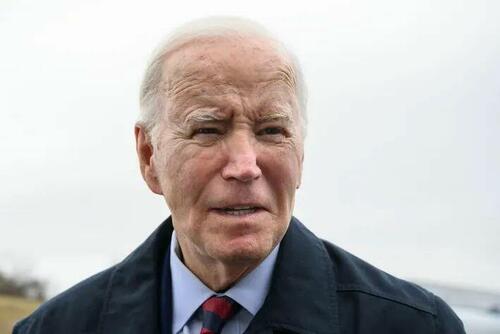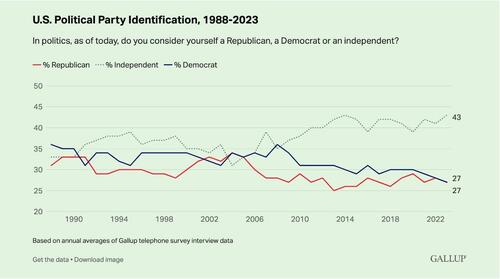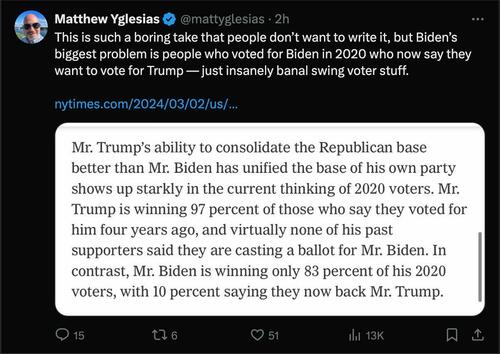
Last weekend, newly-based, former Democrat darling pollster Nate Silver (who recently vanquished a lying leftist academic for spreading misinformation) penned a Saturday blog post in which he noted that President Biden has a huge problem with swing voters.

While Silver acknowledges that there are "relatively few swing voters" in the US, there are some - "and with the country divided roughly 50/50, they usually determine who wins."
What's more, the composition of the electorate has shifted - with a dropoff in those IDing as Democrats loosely corresponding to a rise in those claiming to be independent voters, according to Gallup.
Silver's point? "something has changed over the past decade or so. The Democratic Party brand no longer has an edge on the Republican brand; voters don’t like either one very much."
Biden loses 10%
Silver then brings our attention to a tweet from pundit Matt Yglesias - who highlights a NY Times poll that reveals 10% of 2020 Biden voters are now saying they back Trump.
While Yglesias frames it as "insanely banal swing voter stuff," Silver sees it as far more serious for Democrats.
Via natesilver.net:
I’m a big Yglesias fan, but I’m not sure this take is so boring or so obvious. Here’s a slightly spicy argument, in fact: I suspect that some of the reason that pundits don’t like this take is because the media has become considerably more partisan. In contrast a couple of decades ago, punditry was dominated by newspaper columnists who were milquetoast centrists and TV panelists who were scrupulously nonpartisan. Now, people who comment about politics on blogs and social media tend to be loyal, reliable partisans, aligning with either Democrats or Republicans on nearly every issue. That sort of consistent partisanship is much less common among the broader electorate, although it’s becoming more so.
My theory is that this more partisan species of pundit often implicitly or explicitly advocates for focusing on base turnout because it suits their ideological interests.. These pundits tend to be strong progressives (or conservatives) themselves, and the base-turnout theory implies there’s no trade-off between ideologically-charged policy goals and electoral ones. Read progressive media, for instance, and you’ll often hear that Biden was wise to cancel student loan repayments1 because it would excite young voters, even though student loan relief polls questionably with the electorate overall. I’m not sure I want to get too far into the weeds on Biden’s stance toward the Middle East, but you’ll often hear this argument on Gaza, too. It’s often just assumed (despite poor results for the “uncommitted” protest vote in the Michigan primary on Tuesday) that it would be electorally advantageous for Biden to move to the left by becoming more hawkish toward Bibi Netanyahu, even though Americans overall are still more sympathetic to Israel than Palestine.
The Times/Siena poll that Yglesias alluded to speaks to the potential dangers for Democrats of the base-turnout focus. The poll asked voters who they voted for in 2020 as well as who they plan to vote for in November. This produced a big gap; Biden actually led by 12 points in the recalled 2020 vote, but he trails Trump by 5 points in 2024 voter preferences:
-
2020 recalled vote (excluding nonvoters): Biden 53%, Trump 41%
-
2024 vote (including learners): Trump 48%, Biden 43%
Now, this is a weird result – Biden actually won in 2020 by 4.5 percentage points, not 12. It may reflect the fact that voters sometimes incorrectly recall their previous votes and there can be a bias toward the candidate who won the prior election (in this case, Biden). Nevertheless, this is a bad data point for White House. In the poll, only 83 percent of voters who say they chose Biden in 2020 plan to vote for him this year, whereas 97 percent who voted for Trump plan to vote for Trump again.
These are swing voters, in other words — people who are explicitly stating to pollsters that they are switching their vote from 2020. There are a substantial number of them.
* * *
Not everyone, including Fast Company contributor James Surowiecki, can accept reality:
Yes, 10% of Biden 2020 voters now say they're going to vote for Trump in 2024, as compared to <1% of Trump 2020 voters who now say they're going to vote for Biden. They are switching their votes and not just undecided. https://t.co/13BB64wx7c
— Nate Silver (@NateSilver538) March 4, 2024
Of course, the 2024 election will ultimately come down to whether Trump voters can overcome "the Democrats fraudulent voting scheme," according to the former president.
The upcoming election in November has got to be TOO BIG TO RIG.
— 🇺🇲 Silent Silas 🇺🇲 (@RagingKuJo1222) March 2, 2024
It's the only way to overcome the Democrats fraudulent voting scheme.
This is the only way for Trump in November to be elected. pic.twitter.com/87jtuVcuT4
Last weekend, newly-based, former Democrat darling pollster Nate Silver (who recently vanquished a lying leftist academic for spreading misinformation) penned a Saturday blog post in which he noted that President Biden has a huge problem with swing voters.

While Silver acknowledges that there are “relatively few swing voters” in the US, there are some – “and with the country divided roughly 50/50, they usually determine who wins.”
What’s more, the composition of the electorate has shifted – with a dropoff in those IDing as Democrats loosely corresponding to a rise in those claiming to be independent voters, according to Gallup.
Silver’s point? “something has changed over the past decade or so. The Democratic Party brand no longer has an edge on the Republican brand; voters don’t like either one very much.”
Biden loses 10%
Silver then brings our attention to a tweet from pundit Matt Yglesias – who highlights a NY Times poll that reveals 10% of 2020 Biden voters are now saying they back Trump.
While Yglesias frames it as “insanely banal swing voter stuff,” Silver sees it as far more serious for Democrats.
Via natesilver.net:
I’m a big Yglesias fan, but I’m not sure this take is so boring or so obvious. Here’s a slightly spicy argument, in fact: I suspect that some of the reason that pundits don’t like this take is because the media has become considerably more partisan. In contrast a couple of decades ago, punditry was dominated by newspaper columnists who were milquetoast centrists and TV panelists who were scrupulously nonpartisan. Now, people who comment about politics on blogs and social media tend to be loyal, reliable partisans, aligning with either Democrats or Republicans on nearly every issue. That sort of consistent partisanship is much less common among the broader electorate, although it’s becoming more so.
My theory is that this more partisan species of pundit often implicitly or explicitly advocates for focusing on base turnout because it suits their ideological interests.. These pundits tend to be strong progressives (or conservatives) themselves, and the base-turnout theory implies there’s no trade-off between ideologically-charged policy goals and electoral ones. Read progressive media, for instance, and you’ll often hear that Biden was wise to cancel student loan repayments because it would excite young voters, even though student loan relief polls questionably with the electorate overall. I’m not sure I want to get too far into the weeds on Biden’s stance toward the Middle East, but you’ll often hear this argument on Gaza, too. It’s often just assumed (despite poor results for the “uncommitted” protest vote in the Michigan primary on Tuesday) that it would be electorally advantageous for Biden to move to the left by becoming more hawkish toward Bibi Netanyahu, even though Americans overall are still more sympathetic to Israel than Palestine.
The Times/Siena poll that Yglesias alluded to speaks to the potential dangers for Democrats of the base-turnout focus. The poll asked voters who they voted for in 2020 as well as who they plan to vote for in November. This produced a big gap; Biden actually led by 12 points in the recalled 2020 vote, but he trails Trump by 5 points in 2024 voter preferences:
-
2020 recalled vote (excluding nonvoters): Biden 53%, Trump 41%
-
2024 vote (including learners): Trump 48%, Biden 43%
Now, this is a weird result – Biden actually won in 2020 by 4.5 percentage points, not 12. It may reflect the fact that voters sometimes incorrectly recall their previous votes and there can be a bias toward the candidate who won the prior election (in this case, Biden). Nevertheless, this is a bad data point for White House. In the poll, only 83 percent of voters who say they chose Biden in 2020 plan to vote for him this year, whereas 97 percent who voted for Trump plan to vote for Trump again.
These are swing voters, in other words — people who are explicitly stating to pollsters that they are switching their vote from 2020. There are a substantial number of them.
* * *
Not everyone, including Fast Company contributor James Surowiecki, can accept reality:
Yes, 10% of Biden 2020 voters now say they’re going to vote for Trump in 2024, as compared to <1% of Trump 2020 voters who now say they’re going to vote for Biden. They are switching their votes and not just undecided. https://t.co/13BB64wx7c
— Nate Silver (@NateSilver538) March 4, 2024
Of course, the 2024 election will ultimately come down to whether Trump voters can overcome “the Democrats fraudulent voting scheme,” according to the former president.
The upcoming election in November has got to be TOO BIG TO RIG.
It’s the only way to overcome the Democrats fraudulent voting scheme.
This is the only way for Trump in November to be elected. pic.twitter.com/87jtuVcuT4
— 🇺🇲 Silent Silas 🇺🇲 (@RagingKuJo1222) March 2, 2024
Loading…







